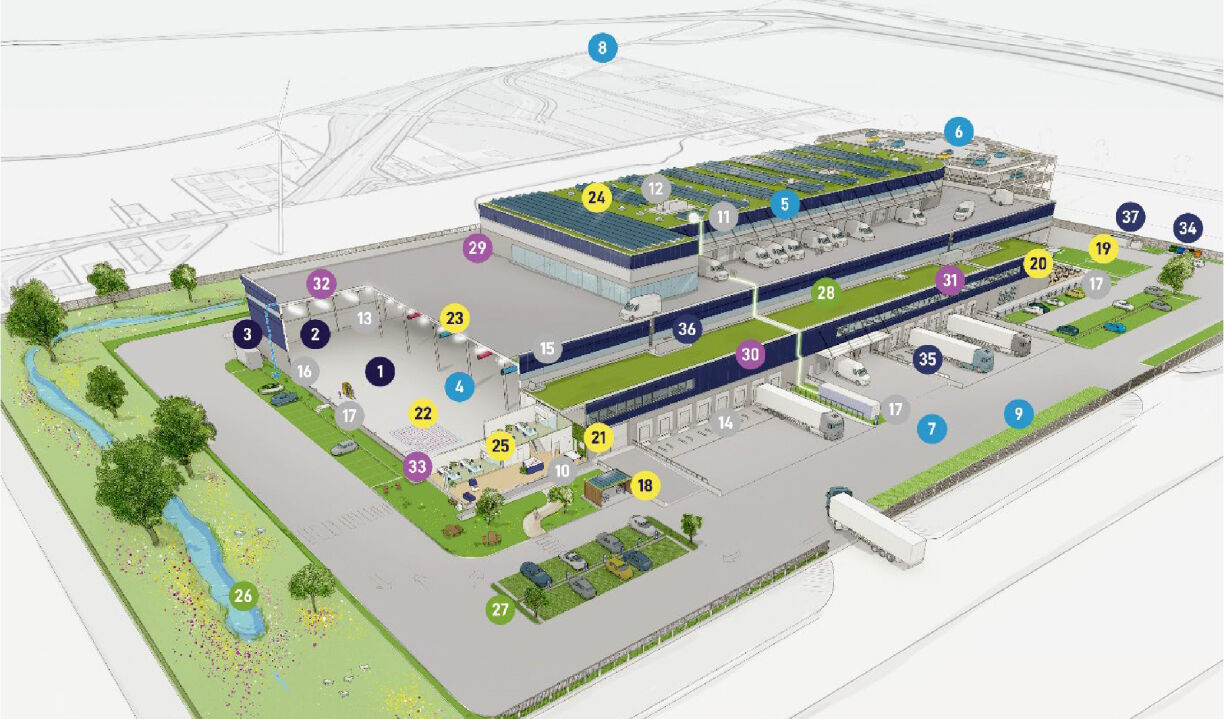
1. Multifunctional spaces with standard dimensions and large spans allow for flexible use of the building.
2. A building with sufficient free height, making it suitable for multiple solutions.
3. Rainwater collection and reuse saves water and promotes sustainability.
4. Optimal use of floor space promotes efficient logistics.
5. Multi-storey design saves square metres of land.
6. Efficient parking through the use of parking garages.
7. Redeveloped brownfield combines environmental benefits with economic development and social improvement.
8. Located on a strategic and multimodal location.
9. Waiting zones for trucks limit nuisance in the wider vicinity of the site.
10. Monitoring of all major energy consumers ensures more efficient use of energy and awareness.
11. High-yield solar panels combined with energy storage ensure optimal use of renewable energy.
12. High-tech heat pumps generate renewable energy. In this way, our sites are disconnected from the gas grid and therefore are fossil-free.
13. SMART LEDs with motion and daylight sensors reduce energy consumption.
14. Super-insulated dock levellers reduce energy consumption.
15. High insulation value and improved airtightness reduces energy consumption and improves comfort.
16. Use of low-CO2
materials drastically reduce embodied carbon.
17. Electric charging points for cars, e-vans, trucks and forklifts encourage electric driving and contribute to reducing overall emissions.
18. Bicycle parking with electric charging stations promote movement and health of employees.
19. Sports facilities promote health, performance and recovery of employees.
20. Atmospheric coffee corners are a social place to relax.
21. Green walls reduce stress and promote well-being and productivity.
22. Underfloor heating is comfortable and energy efficient.
23. Ventilation and cooling is energy-efficient, comfortable and promotes the health of employees.
24. Smart skylights or façade lights bring in natural daylight and create a pleasant and healthy working environment.
25. Waiting rooms and sanitary facilities for drivers ensure a pleasant environment for everyone.
26. Flower meadows, beehives, water buffer basins improve biodiversity.
27. Green car parks promote natural infiltration of rainwater, thermal regulation and water regulation.
28. Green roofs absorb rainwater, provide a haven for birds and insects, lower the ambient temperature and promote clean air.
29. We determine the total environmental impact of a material throughout its life cycle using the LCA method.
30. The facades are built up in multiple layers and with non-adhesive materials.
31. The design takes into account circular building principles with respect to the implementation of building nodes and materials.
32. The use of PUR and PIR foams is avoided as much as possible because they are very harmful to the environment.
33. Cradle to Cradle (C2C) materials are given preference when choosing finishing materials.
34. Separating waste contributes to a better environment and circular economy.
35. Parking zones and loading docks for trucks are provided with an oil and petrol separator.
36. The use of coolants is limited by providing a hybrid system.
37. Biological purification of company wastewater reduces water consumption.

